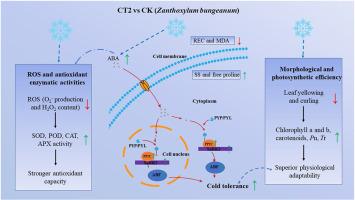花椒的抗寒性与植物激素的稳态有关。
IF 5.7
2区 生物学
Q1 PLANT SCIENCES
引用次数: 0
摘要
花椒(Zanthoxylum bungeanum)是全球重要的香料和经济作物。随着全球气候的极端变化,冬季冻害已成为制约全球辣椒产业发展的重要因素。因此,对辣椒抗寒种质进行筛选,进行抗寒育种和开发花椒‘九叶青’栽培具有重要意义。本研究通过越冬生理生化分析筛选了耐冷菌株2 (CT2)。通过转录组学分析,系统地研究了CT2在自然越冬过程中的耐寒机制。结果表明,与对照对照(CK)、耐冷品系1 (CT1)和耐冷品系3 (CT3)相比,CT2的叶片黄化和卷曲程度降低,叶绿素a、叶绿素b和类胡萝卜素含量显著提高,越冬生理适应性和光合效率增强。此外,CT2的丙二醛(MDA)含量、相对电导率(REC)和过氧化氢(H2O2)含量以及超氧阴离子(O2-)生成速率显著降低,抗氧化酶活性[超氧化物歧化酶(SOD)、过氧化物酶(POD)、过氧化氢酶(CAT)和抗坏血酸过氧化物酶(APX)]显著升高。转录组学分析发现了大量的候选基因,在“植物激素信号转导”、“淀粉和蔗糖代谢”和“次生代谢生物合成”过程中,注释的DEGs明显富集,有助于CT2的耐寒性增强。此外,CT2在越冬过程中对植物激素信号通路相关基因的表达和内源植物激素水平进行了差异调控,表明花椒的抗寒机制涉及植物激素的信号转导和内源平衡。这些发现为选育耐寒花椒提供了理论基础,并对植物对冷胁迫反应的分子机制提供了有价值的见解。本文章由计算机程序翻译,如有差异,请以英文原文为准。

Homeostasis of phytohormones is involved in cold resistance of Zanthoxylum bungeanum maxim
Zanthoxylum bungeanum ‘Jiuyeqing’ is a globally significant spice and economic crop. With the extreme changes of global climate, winter freezing injury has become a significant limiting factor for the development of global pepper industry. Therefore, there is an important need for the screening of cold-resistant pepper germplasms for cold-resistant breeding and the development of Zanthoxylum bungeanum ‘Jiuyeqing’ cultivation. In this study, we screened the cold-tolerant strain 2 (CT2) by physiological and biochemical analyses during overwintering. Transcriptomic analyses were performed to systematically investigate the cold tolerance mechanisms of CT2 during natural overwintering. The results showed that, compared to control (CK), the cold-tolerant strain 1 (CT1) and the cold-tolerant strain 3 (CT3), CT2 exhibited reduced leaf yellowing and curling, along with significantly higher levels of chlorophyll a, chlorophyll b and carotenoids, demonstrating enhanced physiological adaptability and photosynthetic efficiency during overwintering. Additionally, the contents of malondialdehyde (MDA), relative conductivity (REC), and hydrogen peroxide (H2O2), as well as the rate of superoxide anion (O2−) production, were significantly lower, antioxidant enzyme activities [superoxide dismutase (SOD), peroxidase (POD), catalase (CAT), and ascorbate peroxidase (APX)] were markedly higher in CT2. Transcriptomic analysis identified a large number of candidate genes and annotated DEGs were obviously enriched in the processes of "plant hormone signal transduction", "starch and sucrose metabolism" and "biosynthesis of secondary metabolism", contributing to the enhanced cold tolerance of the CT2. Furthermore, the expressions of genes involved in the plant hormone signaling pathway and endogenous level of plant hormones were differentially regulated in CT2 during overwintering, indicating the cold resistance mechanism of Zanthoxylum bungeanum that involves the signal transduction and endogenous balance of plant hormones. These findings provide a theoretical foundation for breeding cold-resistant Zanthoxylum bungeanum and offer valuable insights into the molecular mechanisms governing the plant's response to cold stress.
求助全文
通过发布文献求助,成功后即可免费获取论文全文。
去求助
来源期刊
CiteScore
11.10
自引率
3.10%
发文量
410
审稿时长
33 days
期刊介绍:
Plant Physiology and Biochemistry publishes original theoretical, experimental and technical contributions in the various fields of plant physiology (biochemistry, physiology, structure, genetics, plant-microbe interactions, etc.) at diverse levels of integration (molecular, subcellular, cellular, organ, whole plant, environmental). Opinions expressed in the journal are the sole responsibility of the authors and publication does not imply the editors'' agreement.
Manuscripts describing molecular-genetic and/or gene expression data that are not integrated with biochemical analysis and/or actual measurements of plant physiological processes are not suitable for PPB. Also "Omics" studies (transcriptomics, proteomics, metabolomics, etc.) reporting descriptive analysis without an element of functional validation assays, will not be considered. Similarly, applied agronomic or phytochemical studies that generate no new, fundamental insights in plant physiological and/or biochemical processes are not suitable for publication in PPB.
Plant Physiology and Biochemistry publishes several types of articles: Reviews, Papers and Short Papers. Articles for Reviews are either invited by the editor or proposed by the authors for the editor''s prior agreement. Reviews should not exceed 40 typewritten pages and Short Papers no more than approximately 8 typewritten pages. The fundamental character of Plant Physiology and Biochemistry remains that of a journal for original results.

 求助内容:
求助内容: 应助结果提醒方式:
应助结果提醒方式:


